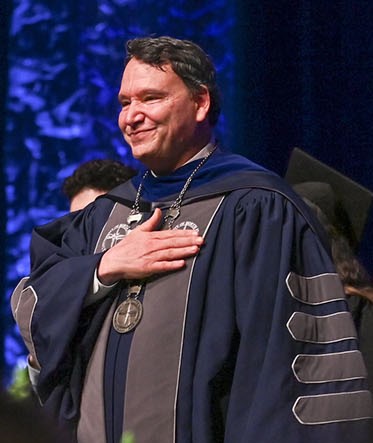Ceremonial Traditions
Regalia
Academic regalia dates back to European universities of the Middle Ages, when gowns and hoods were required for warmth in unheated buildings. Gowns were fur lined adaptations of the priestly toga, and hoods were worn to protect the tonsured heads of the priests. The regalia now serves as a visible reminder of the historic antecedents of intellectual pursuits.
In American universities of the late 19th century, these medieval costumes were revived to lend color to academic functions. Efforts were made to establish a code that would set standards for academic dress. Gowns of masters and doctors are generally ankle length and closed in front. The master’s gown has pointed sleeves that are slit at the elbows. The doctoral gown has wide lapels of velvet, either black or the color of the scholar’s specialization. The sleeves are full and bell shaped, with three velvet chevrons, either black or colored like the lapels. Gowns normally are black, although some universities have designed their own in the colors of the institution.
The hood, which drapes over the back of the gown, carries the greatest symbolism of all components of the academic costume. Its length, width and colors denote the wearer’s highest academic achievement and institution. The master’s hood is pointed; the doctoral hood is bell shaped. The color of the border of the hood indicates the scholar’s major field of study; the lining color or colors identifies the institution that conferred the wearer’s degree. Hoods were originally trimmed in fur, but now have satin borders for masters’ and velvet for doctors’ hoods.
The customary head covering is the mortarboard, or Oxford cap, with a tassel on the left side. Persons who possess the doctorate wear a tassel of gold metallic threads. The soft, large beret, modeled after the cap of Cambridge University, also has been adopted by some institutions.
The medieval university was much concerned with rank and privilege, and academic robes made visible the social and academic distinctions of the wearers. These distinctions have largely disappeared, and robes now indicate specialization.
University Mace and Presidential Medallion
 The University’s mace design is a staff made of wood that carries the official seal for the University. The mace is always at the head of a processional for formal University functions, such as commencements and inaugurations. It is an honor for a faculty member to be selected to carry the mace.
The University’s mace design is a staff made of wood that carries the official seal for the University. The mace is always at the head of a processional for formal University functions, such as commencements and inaugurations. It is an honor for a faculty member to be selected to carry the mace.
The University’s medallion is worn by the president and incorporates the University’s seal. The seal includes a circle and a compass rose – a direction-finding device for mariners.
These symbols represent the University’s role in providing direction for students. The placement of the symbol in the northeast quadrant of the circle describes the University’s location in Northeast Florida. The Roman numerals refer to the year the University was chartered, 1965.
UNF Alma Mater
VERSE:
We recall those days of gladness,
Nestled midst the lakes and pine,
Where we sought the gift of knowledge,
Alma Mater, pride of mine.
REFRAIN:
Sing her glory and her praises,
Let them ring from sea to sea!
North Florida we proudly honor,
U-N-F, all hail to thee.
VERSE:
Near the shores of the Atlantic,
Where the Osprey soars on high,
Stands our Alma Mater strong and true,
With her colors gray and blue.
REPEAT REFRAIN

